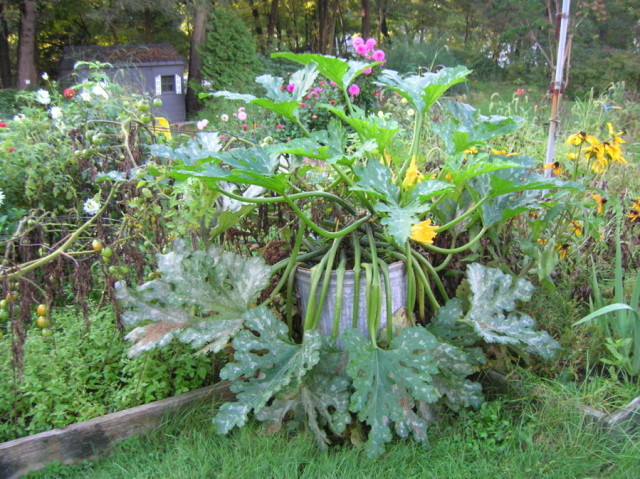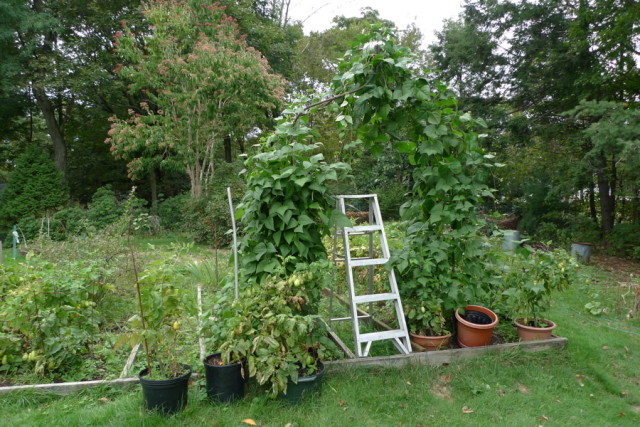Lessons from My Mother’s Garden

The best use I can think of for an old trash can…
My mother has always had a way with plants. Houseplants, vegetables, and flowers all flourish under her care. While she’s always grown zinnias, dahlias, and gladiolus for cutting, her most intensive gardening has always revolved around growing food. As she had been a child in Germany during World War II, she had loathed vegetables she called "famine food," such as kale. Later, she’d lived in France, where she’d developed an appreciation for European vegetables that few New Englanders in the 50s and 60s grew, much less ate: French filet beans, elegant leaf lettuces, escarole, and petit pois (peas). She was way ahead of her time, hanging her clothes out on the line to dry (my parents have never had a drier), composting every scrap her kitchen produced, starting seeds in eggshells and milk cartons and making her own potting soil from scratch.
She has a unique way of gardening, which she imparted to us as children. It is idiosyncratic and based on personal experimentation, not on any authority’s ideas about how to garden. She rarely follows rules or experts’ tips – she learns by trying things. Just watching her digging, weeding, sowing and harvesting – creating a flourishing empire of food plants and flowers – has made gardening seem like the most natural thing in the world to me.
She has a gut feeling about how to grow plants. Which is to say, she is an astute observer. For I’m convinced this skill lies at the heart of good gardening. Knowing how to garden comes from observing and experimenting. And she tries new things all the time, remembering what works and, when they don’t, trying something else until she gets it right.
When I visit, I always check to see the results of her latest propagation efforts. A couple of weeks ago when I arrived and took my first walk around the garden, I saw she had a new, foot-high seven son flower tree (Heptacodium miconioides). This unusual tree from China has beautiful peeling bark and tiny, jasmine-scented white summer flowers followed by rich, rosy-red calyces that look like a second flowering all autumn. (It’s cold-hardy enough for Boston but does wonderfully in Portland, too.) I asked her about the new plant and she said a branch had broken off her mother tree so she’d stuck it in a patch of compost and it had rooted. The horticultural smartie-pants in me would like to attribute it to a rational set of conditions: the combination of sandy, well-drained soil, the addition of rich compost, and proper timing. But I know better – it’s undoubtedly my mother’s special garden magic – no less finely tuned for her being 80 years old.
She does the same thing with fig, hibiscus, hydrangea, gardenia, lavender, boxwood, geranium, and myriad other plants she grows both indoors and out. No rooting hormone, Perlite or mist benches… just knowledge, instinct and, every once in a while, for a special plant, a little plastic bag "tent" propped up with chopsticks to keep up the humidity level while the plants are rooting.

The vines have withered but the squash (old-fashioned Waltham Butternut) is ready to harvest. This barrow was just sitting right by the back door – ready to harvest for a meal. Which she did, the night before I left.
She can grow nearly anything from seed. Sometimes she buys seeds and sometimes she just harvests seed from her own plants. One of her best cultivation tricks is to plant squash seed in an aging compost heap. The vines scramble around the wire enclosure but the roots are buried in the rich, warm, mellowing compost. She knows just when to plant the seeds (no need to consult charts) and in what part of the pile they receive maximum warmth and nourishment but don’t "burn".
When I was a teenager, I was nervous when she trolled the town dump for interesting finds. But my nervousness turned to pride when I returned from college and saw what she was doing with the old rusted-out metal trash cans and wheelbarrows… She just shoveled home-made compost into the bins, mixed with some sandy New England garden soil, and planted them up with vegetables. It worked beautifully and was considered quite outre in the 1980s.

Foreground: the bean trellis (fancy French trellis from the town dump) covered in delicious French beans – how apropos! The ladder stays in place all summer and fall, to ease the daily harvest. Now that’s the ultimate fresh produce! Background: Heptacodium miconioides tree (from an Arnold Arboretum plant sale about 10 years ago). This plant apparently can root when a piece is just stuck in the ground. But maybe you have to be my mother to succeed at this?
My mother has been gardening and sharing her garden’s bounty with family, friends and neighbors since the mid-60s. Forty-five years’ worth of kitchen scraps from a superb cook preparing three meals a day for a household full of people has resulted in what must be the richest garden soil in New England. My mother’s style of gardening illustrates what gardening can be, at its best – a way to keep body and mind engaged and strong over the years, a profound way of tuning in to the seasons and cycles of nature, and a passion that feeds you and everyone near you over the course of an entire lifetime.
